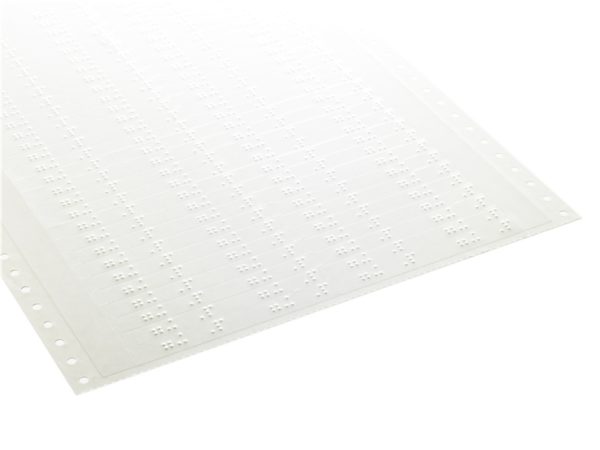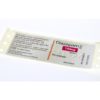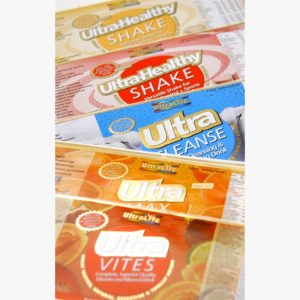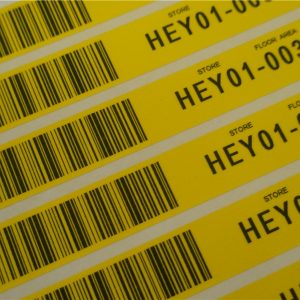Braille Labels
Home / Full Product Range / Full Product Range / Braille Labels
Labelservice has years of experience in supplying fully bespoke braille labels. These can be printed directly onto another label (eg, a chemical raised warning triangle over a hazardous symbol or pharmaceutical packaging) or supplied as a seperate item. We supply to your printing specifications on either rolls or sheets, on clear or white base stock.
The material used exceeds the requirements of the MHRA regulartory body, meaning the raised dots withstand extreme changes of temperature and heavy pressure.
Braille Labels
Braille labels, also known as Braille stickers, are adhesive labels embossed with Braille characters which translate printed text into a tactile format that can be read by individuals with visual impairments.
In the UK there are 340,000 people registered as being blind, of which 30,000 people regularly use braille as part of their everyday life, including at home, at work and in public settings.
- Medication Labelling:
Braille labels are mandatory on medication packaging. They can be used to label medicine bottles, blister packs, or medicine boxes with the name of the medication, dosage, and schedule. This ensures that individuals with visual impairments can independently manage their medications and reduces the risk of medication errors.
- Food and Beverage Labelling:
In the kitchen, Braille labels help in identifying different food items and beverages. They can be used to label containers with the contents and expiry dates, aiding in meal preparation and ensuring food safety. For instance, labelling on jars, canned goods, or milk cartons.
- Appliance Labelling:
Braille labels can be affixed to various household appliances like microwaves, ovens, washing machines, and fridges to indicate buttons, settings, and operating instructions. For example, labelling the temperature dials and timers on ovens or the different wash cycles on washing machines can be immensely helpful.
- Personal Item Identification:
Personal items such as clothing, shoes, and personal care products can be labelled to help with easier identification. For instance, Braille labels can be used to indicate colours of clothing or types of personal care products like shampoo and conditioner, allowing individuals to independently choose and use these items.
- Organisation and Storage:
Braille labels can help with organising shelves, drawers, and storage containers. They help in categorising and identifying stored items, be it in the kitchen, study, or bedroom.
- Room and Office Labelling:
The use of Braille labels on office doors, meeting rooms, and restrooms can help visually impaired staff navigate around an office. Moreover, while it might not always be feasible to alter the lifts, adding Braille labels to the lift buttons can at least make the journey between floors a more independent experience.
- Equipment and Appliance Labelling:
Most people in the office love their coffee or tea fix, so labels on machines can be helpful along with tea and coffee pots. Similarly, the microwave can be made user-friendly with Braille labels indicating different settings. The photocopier and fax machines can also be made accessible by labelling the right buttons with Braille. Even the water dispensers can be labelled to indicate hot or cold water.
- File and Document Organisation:
Labelling documents and files with braille labels.
- Emergency Exit and Safety Equipment Labelling:
The labelling of emergency exits, fire extinguishers, and first-aid kits with Braille is crucial for ensuring the safety of visually impaired staff.
- Stationery and Supply Labelling:
Braille can be used to label different coloured pens and cables. Even company ID cards can be labelled with braille.
Braille stickers are commonly used on buses and trains, such as seat numbers, emergency exits, and next stop information. Educational institutions utilise them to label room numbers, toilets, and library sections. Healthcare facilities, government buildings and branks use Braille labels to denote room numbers, departments, and emergency facilities. Public spaces like parks and museums, shopping centres, and eateries all use Braille labels.
It is mandatory in the UK to have Braille labelling on the packaging of medicinal products. The Braille labelling on medications typically includes the name of the product and strength of the medicine, which aids in the correct identification of the medicine. The European Union introduced a directive (Directive 2004/27/EC) which made it mandatory for member states to have Braille labelling on medicinal products. The UK, despite Brexit, has continued to uphold this directive to ensure the safety and accessibility of medications for all individuals. This was adopted on 31st March 2004 and implemented in October 2005.
For hazardous products, the legal requirements in the UK are governed by the Classification, Labelling and Packaging of Substances and Mixtures (CLP) Regulation. These regulations mandate that hazardous substances be clearly labelled with pictograms and warnings to indicate the nature of the hazards they present. However, currently, there isn’t a specific legal requirement mandating the use of Braille on the packaging of hazardous substances such as chemicals
Labelservice has years of experience in supplying fully bespoke braille labels. These can be printed directly onto another label (eg, a chemical raised warning triangle over a hazardous symbol or pharmaceutical packaging) or supplied as a seperate item. We supply to your printing specifications on either rolls or sheets, on clear or white base stock.
The material used exceeds the requirements of the MHRA regulartory body, meaning the raised dots withstand extreme changes of temperature and heavy pressure.
Braille Labels
Braille labels, also known as Braille stickers, are adhesive labels embossed with Braille characters which translate printed text into a tactile format that can be read by individuals with visual impairments.
In the UK there are 340,000 people registered as being blind, of which 30,000 people regularly use braille as part of their everyday life, including at home, at work and in public settings.
- Medication Labelling:
Braille labels are mandatory on medication packaging. They can be used to label medicine bottles, blister packs, or medicine boxes with the name of the medication, dosage, and schedule. This ensures that individuals with visual impairments can independently manage their medications and reduces the risk of medication errors.
- Food and Beverage Labelling:
In the kitchen, Braille labels help in identifying different food items and beverages. They can be used to label containers with the contents and expiry dates, aiding in meal preparation and ensuring food safety. For instance, labelling on jars, canned goods, or milk cartons.
- Appliance Labelling:
Braille labels can be affixed to various household appliances like microwaves, ovens, washing machines, and fridges to indicate buttons, settings, and operating instructions. For example, labelling the temperature dials and timers on ovens or the different wash cycles on washing machines can be immensely helpful.
- Personal Item Identification:
Personal items such as clothing, shoes, and personal care products can be labelled to help with easier identification. For instance, Braille labels can be used to indicate colours of clothing or types of personal care products like shampoo and conditioner, allowing individuals to independently choose and use these items.
- Organisation and Storage:
Braille labels can help with organising shelves, drawers, and storage containers. They help in categorising and identifying stored items, be it in the kitchen, study, or bedroom.
- Room and Office Labelling:
The use of Braille labels on office doors, meeting rooms, and restrooms can help visually impaired staff navigate around an office. Moreover, while it might not always be feasible to alter the lifts, adding Braille labels to the lift buttons can at least make the journey between floors a more independent experience.
- Equipment and Appliance Labelling:
Most people in the office love their coffee or tea fix, so labels on machines can be helpful along with tea and coffee pots. Similarly, the microwave can be made user-friendly with Braille labels indicating different settings. The photocopier and fax machines can also be made accessible by labelling the right buttons with Braille. Even the water dispensers can be labelled to indicate hot or cold water.
- File and Document Organisation:
Labelling documents and files with braille labels.
- Emergency Exit and Safety Equipment Labelling:
The labelling of emergency exits, fire extinguishers, and first-aid kits with Braille is crucial for ensuring the safety of visually impaired staff.
- Stationery and Supply Labelling:
Braille can be used to label different coloured pens and cables. Even company ID cards can be labelled with braille.
Braille stickers are commonly used on buses and trains, such as seat numbers, emergency exits, and next stop information. Educational institutions utilise them to label room numbers, toilets, and library sections. Healthcare facilities, government buildings and branks use Braille labels to denote room numbers, departments, and emergency facilities. Public spaces like parks and museums, shopping centres, and eateries all use Braille labels.
It is mandatory in the UK to have Braille labelling on the packaging of medicinal products. The Braille labelling on medications typically includes the name of the product and strength of the medicine, which aids in the correct identification of the medicine. The European Union introduced a directive (Directive 2004/27/EC) which made it mandatory for member states to have Braille labelling on medicinal products. The UK, despite Brexit, has continued to uphold this directive to ensure the safety and accessibility of medications for all individuals. This was adopted on 31st March 2004 and implemented in October 2005.
For hazardous products, the legal requirements in the UK are governed by the Classification, Labelling and Packaging of Substances and Mixtures (CLP) Regulation. These regulations mandate that hazardous substances be clearly labelled with pictograms and warnings to indicate the nature of the hazards they present. However, currently, there isn’t a specific legal requirement mandating the use of Braille on the packaging of hazardous substances such as chemicals






















